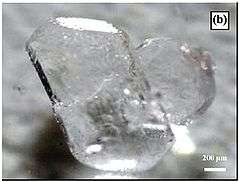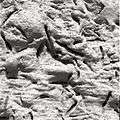Meridianiite
| Meridianiite | |
|---|---|
 | |
| General | |
| Category | Sulfate minerals |
| Formula (repeating unit) | Magnesium sulfate 11 hydrate MgSO4•11H2O |
| Strunz classification | 7.CB.90 |
| Crystal system | Triclinic |
| Crystal class |
Pinacoidal (1) (same H-M symbol) |
| Space group | P1 |
| Unit cell |
a = 6.7459 Å, b = 6.8173 Å, c = 17.299 Å; α = 88.137°, β = 89.481°, γ = 62.719°; Z = 2 |
| Identification | |
| Formula mass | 318.55 g/mol |
| Color | Colorless or white |
| Crystal habit | Needle-shaped to broad flat crystals |
| Tenacity | Brittle |
| Luster | Vitreous - dull |
| Streak | White |
| Diaphaneity | Transparent |
| Specific gravity | 1.512 |
| Melting point | At temperatures above 2 ˚C |
| Solubility | Highly soluble in water |
| References | [1][2] |
Meridianiite — MgSO4•11H2O — is the crystalline 11-hydrate magnesium sulfate phase that precipitates from solutions saturated in Mg2+ and SO42− ions at temperatures less than 2 ˚C. Clear to colorless, it is a naturally occurring mineral species found on Earth in a variety of environments including sea ice, crusts and efflorescence’s in coal/metal mines, cave systems, oxidized zones of sulfide deposits, salt lakes/playa’s and Antarctic ice-cores. Named for locality data obtained by the NASA Opportunity Rover at Meridiani Planum,[1] it has been suggested that mineral casts present in the Martian sulfate deposits are indicative of this minerals former presence in the area. It is commonly associated with other evaporite minerals such as epsomite, mirabilite, halides, and other sodium-magnesium-sulfates.
Properties
Meridianiite belongs to the triclinic crystal system, having cell parameters a = 6.7459 Å, b = 6.8173 Å, c = 17.299 Å, a density = 1.512 g/cm-3, x-ray diffraction peaks at d-spacing’s = 5.73, 5.62, 5.41, 4.91, 4.85, 2.988, 2.958 (highest intensity), and 2.940, and is IR active. It produces needle-shaped to broad flat crystals that are clear to colorless-white, and decomposes incongruently above 2 °C to produce epsomite (MgSO4•7H2O) and water.
Discovery
Originally described in 1837 by C.J. Fritzsche as being a 12-hydrate member of the Mg-sulfate salts, it was known at the time as Frizsche’s Salt and not formally given a mineral name or designation. Its chemical formula was initially determined by calculating the weight loss from the crystal structure during dehydration as it transformed to anhydrous MgSO4. The crystal structure was later resolved by Peterson and Wang in 2006, revealing it belonged to the triclinic crystal system, and possessed 11 waters of hydration, not 12. Meridianiite was officially named and approved as a new mineral species by the Commission on New Mineral Names and Mineral Nomenclature of the International Mineralogical Association in November 2007.
Planetary mineralogy
The fundamental principle of comparative planetary geology is that geological processes on other planets or moons operate in much the same manner as they do on Earth, at least for planetary bodies of similar size and composition. This has been the cornerstone of comparative planetary exploration, and has been the primary method of data interpretation for the current exploration of Mars.
Imagery of the surrounding massive sulfate deposits sent back by the NASA Opportunity Rover in Meridiani Planum, has indicated the existence of pervasive needle-shaped void spaces throughout the deposit. The now empty angular holes are interpreted as being cavities once filled by a highly soluble mineral species, most likely a magnesium sulfate. These cavities are observed to closely match the crystal habit of Meridianiite, and have been proposed as sites where crystals of Meridianiite were located, having subsequently dissolved when environmental conditions rendered the crystal unstable. Due to the decomposition of Meridianiite to 70% epsomite and 30% water, it has been proposed that meridianiite may represent a periodic reservoir of water near the Martian surface. During warmer periods in Mars’ history it is possible that triggered melting of this mineral may help explain the occurrence of some of the chaotic, and short lived, surface-water episodes throughout Martian history.
Remote sensing of other planetary bodies has also indicated the presence of numerous hydrated mineral species, including sulfates, near various planetary surfaces, a prominent example of which is Jupiter’s moon Europa. The relatively smooth, and very young surface of Europa has been interpreted as evidence for a putative ocean beneath the moons icy surface, and is therefore suggestive of liquid brine at depth. Due to the cryospheric conditions present on Europa it is likely that any magnesium sulfate minerals present, and in contact with liquid water, would inherently occur as meridianiite, and thus, it may make up an important mineral phase, and liquid water reservoir at depth.
Gallery
 Figure 1. (a, b, d) Optical images of meridianiite, MgSO4•11H2O. Courtesy Genceli et al. 2007.
Figure 1. (a, b, d) Optical images of meridianiite, MgSO4•11H2O. Courtesy Genceli et al. 2007. Figure 2. Sampling of meridianiite off a wooden post. Courtesy R. Peterson 2010.
Figure 2. Sampling of meridianiite off a wooden post. Courtesy R. Peterson 2010. Figure 3. Type occurrence of meridianiite at Basque Lake No. 1. Courtesy R. Peterson 2010.
Figure 3. Type occurrence of meridianiite at Basque Lake No. 1. Courtesy R. Peterson 2010. Figure 4. Meridianiite mineral type locality; Basque Lake No. 1 as seen in winter 2007. Courtesy R. Peterson 2010.
Figure 4. Meridianiite mineral type locality; Basque Lake No. 1 as seen in winter 2007. Courtesy R. Peterson 2010. Figure 5. Long needle-shaped crystal void cavities as observed by the NASA Opportunity Rover at Meridiani Planum, Mars. Image courtesy R. Peterson 2010, and NASA.
Figure 5. Long needle-shaped crystal void cavities as observed by the NASA Opportunity Rover at Meridiani Planum, Mars. Image courtesy R. Peterson 2010, and NASA. Figure 6. Temperature vs. weight % MgSO4 diagram depicting the stability ranges of the various pure magnesium sulfate hydrated salts. Courtesy R. Peterson 2010.
Figure 6. Temperature vs. weight % MgSO4 diagram depicting the stability ranges of the various pure magnesium sulfate hydrated salts. Courtesy R. Peterson 2010. Figure 7. X-Ray diffraction data obtained using a Cobalt source for the magnesium sulfate hydrate, Meridianiite. The dotted line is representative of the ideal intensity and spectral pattern of meridianiite. Courtesy R. Peterson 2010.
Figure 7. X-Ray diffraction data obtained using a Cobalt source for the magnesium sulfate hydrate, Meridianiite. The dotted line is representative of the ideal intensity and spectral pattern of meridianiite. Courtesy R. Peterson 2010. Figure 8. Infrared absorption of meridianiite. Courtesy R. Peterson 2010.
Figure 8. Infrared absorption of meridianiite. Courtesy R. Peterson 2010.
References
| Wikimedia Commons has media related to Meridianiite. |
- Genceli, F.E., Lutz, M., Spek, A.L., Witkamp, G-J., (2007). Crystallization and characterization of a new magnesium sulfate hydrate MgSO4•11H2O. Crystal Growth & Design, 7, 2460-2466.
- Genceli, F.E., Horikawa, S., Iizuka, Y., Toshimitsu, S., Hondoh, T., Kawamura, T., Witkamp, G-J., (2009). Meridianiite detected in ice. Journal of Glaciology, 189, 117-122.
- Dalton, J.B., (2003). Spectral behavior of hydrated sulfate salts: Implications for Europa mission spectrometer design. Astrobiology, 3, 771-784.
- Peterson, R.C., and Wang, R. (2006). Crystal molds on Mars: Melting of a possible new mineral species to create Martian chaotic terrain. Geology, 34, 957–960.
- Fortes, A.D., Wood, I.G., Knight, K.S., (2008). The crystal structure and thermal expansion tensor of MgSO4•11D2O (meridianiite) determined by neutron powder diffraction. Physics and Chemistry of Minerals, 35, 207-221.
- Peterson, R.C., Nelson, W., Madu, B., Shurvell, H.F., (2007). Meridianiite: A new mineral species observed on Earth and predicted to exist on Mars. American Mineralogist, 92, 1756-1759.